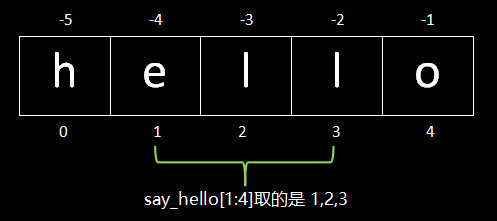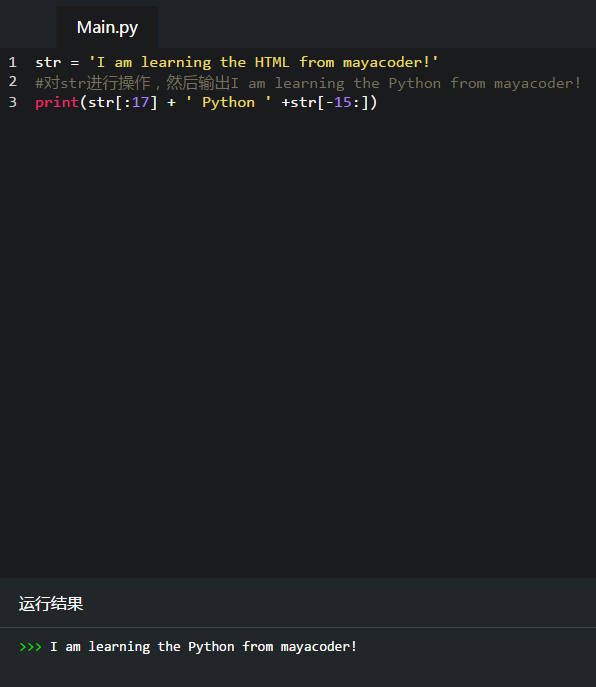 Backend Development
Backend Development
 Python Tutorial
Python Tutorial
 Python novices learn basic data types - slicing and intercepting strings
Python novices learn basic data types - slicing and intercepting strings
Python novices learn basic data types - slicing and intercepting strings
Slice interception is some common string operations in Python. We will introduce it in detail in this article. The function of slice interception is to obtain subcharacters or substrings.
In fact, what we have to do is to use indexes and separate the two indexes with a colon, in the form: variable [head subscript: tail subscript], the number before the colon represents the starting position, and the number after the colon represents the end. Location. This is a left-closed and right-open interval, which means that this string contains the head subscript, but does not contain the tail subscript.
Python data has two indexing methods: the leftmost element starts with 0 and increases in order; the rightmost element index is -1 and decreases in order to the left.
Python’s indexing is very flexible, and you can choose the corresponding indexing method according to the specific situation.
String index
Use the index to get a certain character in the string. Just use the subscript [x] directly. Don’t forget that the index starts from 0!
For example, for a string language="Python", 'P' can be obtained by using language[1] and lanuage[-5].
Split, slice and intercept
Python’s slicing operation often uses split slices, that is, using colons (:) in [] to split strings.
Take say_hell= 'hello' as an example:

As mentioned above, the syntax for using slices is: string variable name [x:y], which represents a period of characters with subscripts from x to y String (excluding y). When x is not written as, like [:y], it means starting from the beginning, equivalent to [0:y]. When y is not written, it means all the way to the end. When neither x nor y is written, it represents the entire string.
Step size slice interception
Step size interception, unlike the previous slice interception operation, it takes the value according to a certain number of "steps".
The syntax is:
Use two colons, such as
Python code
[X::y]
, x means starting from x, y means taking y steps to take a value, and continue until the end. For example, taking the previous str [1::3], that is, starting from the second character, taking a value every 3 bits, the result is eo.
Try!
We have learned to operate and slice strings, so now let’s consolidate the review and do an exercise:
Strings can be concatenated using (+) or (*) Repeat.
Strings can be accessed using index (str[index]).
Strings support slicing operations. Use colon : in [] to split the string and intercept a certain segment of the string.
Strings can be intercepted every few times using step size [x::y] slicing.
Use the knowledge you learned earlier, intercept "I am learning the HTML from mayacoder!" and output "I am learning the Python from mayacoder!". Don't forget that spaces are also characters.
Think about it~~
The answer to the code is this (not the only one):


Hot AI Tools

Undresser.AI Undress
AI-powered app for creating realistic nude photos

AI Clothes Remover
Online AI tool for removing clothes from photos.

Undress AI Tool
Undress images for free

Clothoff.io
AI clothes remover

Video Face Swap
Swap faces in any video effortlessly with our completely free AI face swap tool!

Hot Article

Hot Tools

Notepad++7.3.1
Easy-to-use and free code editor

SublimeText3 Chinese version
Chinese version, very easy to use

Zend Studio 13.0.1
Powerful PHP integrated development environment

Dreamweaver CS6
Visual web development tools

SublimeText3 Mac version
God-level code editing software (SublimeText3)

Hot Topics
 PHP and Python: Different Paradigms Explained
Apr 18, 2025 am 12:26 AM
PHP and Python: Different Paradigms Explained
Apr 18, 2025 am 12:26 AM
PHP is mainly procedural programming, but also supports object-oriented programming (OOP); Python supports a variety of paradigms, including OOP, functional and procedural programming. PHP is suitable for web development, and Python is suitable for a variety of applications such as data analysis and machine learning.
 Choosing Between PHP and Python: A Guide
Apr 18, 2025 am 12:24 AM
Choosing Between PHP and Python: A Guide
Apr 18, 2025 am 12:24 AM
PHP is suitable for web development and rapid prototyping, and Python is suitable for data science and machine learning. 1.PHP is used for dynamic web development, with simple syntax and suitable for rapid development. 2. Python has concise syntax, is suitable for multiple fields, and has a strong library ecosystem.
 Python vs. JavaScript: The Learning Curve and Ease of Use
Apr 16, 2025 am 12:12 AM
Python vs. JavaScript: The Learning Curve and Ease of Use
Apr 16, 2025 am 12:12 AM
Python is more suitable for beginners, with a smooth learning curve and concise syntax; JavaScript is suitable for front-end development, with a steep learning curve and flexible syntax. 1. Python syntax is intuitive and suitable for data science and back-end development. 2. JavaScript is flexible and widely used in front-end and server-side programming.
 PHP and Python: A Deep Dive into Their History
Apr 18, 2025 am 12:25 AM
PHP and Python: A Deep Dive into Their History
Apr 18, 2025 am 12:25 AM
PHP originated in 1994 and was developed by RasmusLerdorf. It was originally used to track website visitors and gradually evolved into a server-side scripting language and was widely used in web development. Python was developed by Guidovan Rossum in the late 1980s and was first released in 1991. It emphasizes code readability and simplicity, and is suitable for scientific computing, data analysis and other fields.
 Can vs code run in Windows 8
Apr 15, 2025 pm 07:24 PM
Can vs code run in Windows 8
Apr 15, 2025 pm 07:24 PM
VS Code can run on Windows 8, but the experience may not be great. First make sure the system has been updated to the latest patch, then download the VS Code installation package that matches the system architecture and install it as prompted. After installation, be aware that some extensions may be incompatible with Windows 8 and need to look for alternative extensions or use newer Windows systems in a virtual machine. Install the necessary extensions to check whether they work properly. Although VS Code is feasible on Windows 8, it is recommended to upgrade to a newer Windows system for a better development experience and security.
 Can visual studio code be used in python
Apr 15, 2025 pm 08:18 PM
Can visual studio code be used in python
Apr 15, 2025 pm 08:18 PM
VS Code can be used to write Python and provides many features that make it an ideal tool for developing Python applications. It allows users to: install Python extensions to get functions such as code completion, syntax highlighting, and debugging. Use the debugger to track code step by step, find and fix errors. Integrate Git for version control. Use code formatting tools to maintain code consistency. Use the Linting tool to spot potential problems ahead of time.
 How to run programs in terminal vscode
Apr 15, 2025 pm 06:42 PM
How to run programs in terminal vscode
Apr 15, 2025 pm 06:42 PM
In VS Code, you can run the program in the terminal through the following steps: Prepare the code and open the integrated terminal to ensure that the code directory is consistent with the terminal working directory. Select the run command according to the programming language (such as Python's python your_file_name.py) to check whether it runs successfully and resolve errors. Use the debugger to improve debugging efficiency.
 Is the vscode extension malicious?
Apr 15, 2025 pm 07:57 PM
Is the vscode extension malicious?
Apr 15, 2025 pm 07:57 PM
VS Code extensions pose malicious risks, such as hiding malicious code, exploiting vulnerabilities, and masturbating as legitimate extensions. Methods to identify malicious extensions include: checking publishers, reading comments, checking code, and installing with caution. Security measures also include: security awareness, good habits, regular updates and antivirus software.





